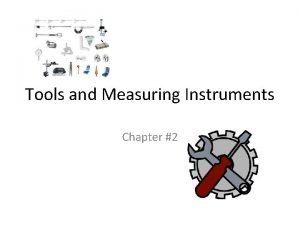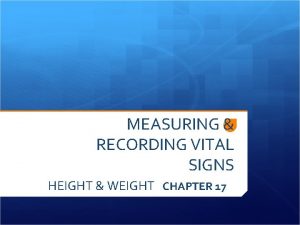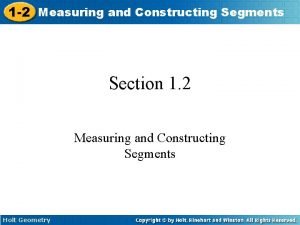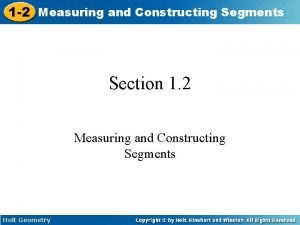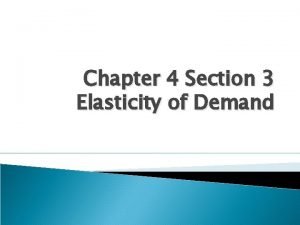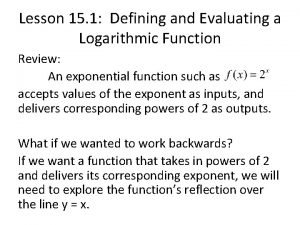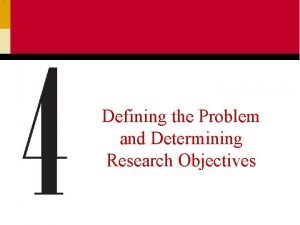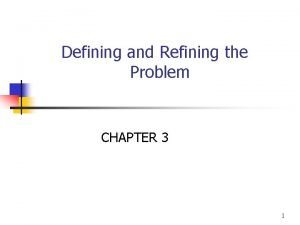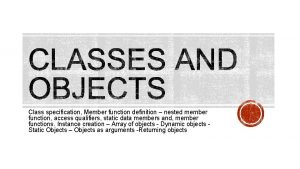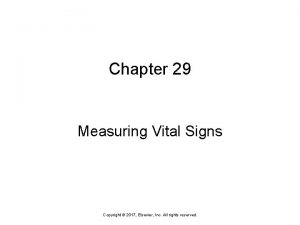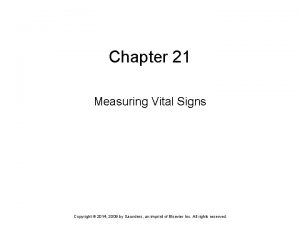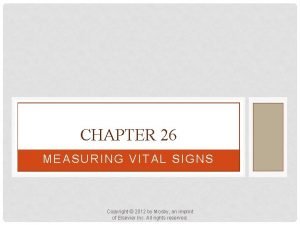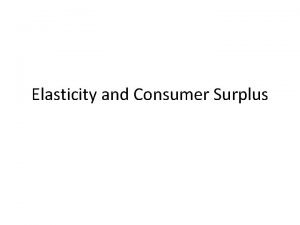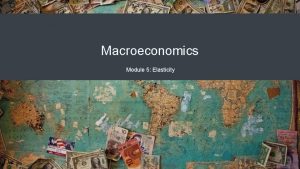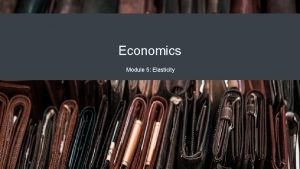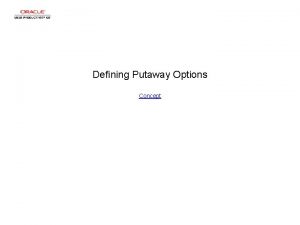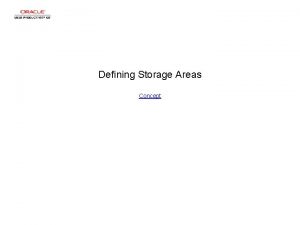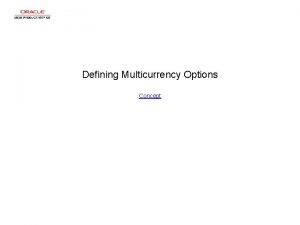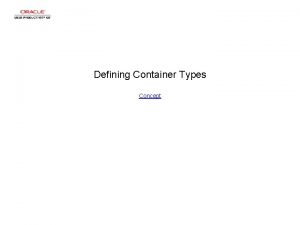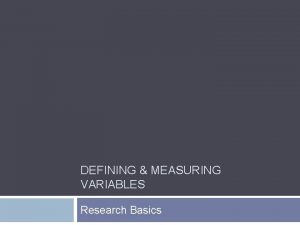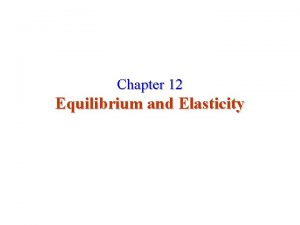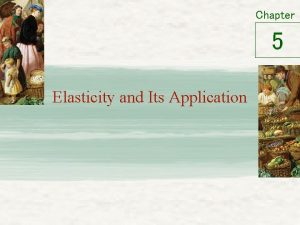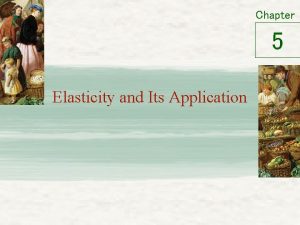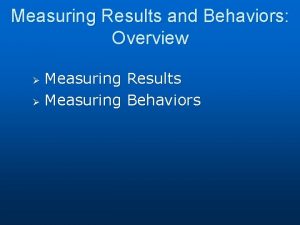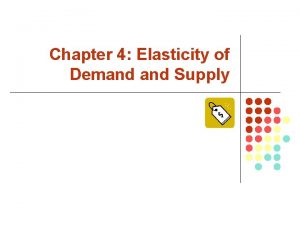CHAPTER 5 Elasticity l Defining and Measuring Elasticity


































- Slides: 34

CHAPTER 5 Elasticity l

Defining and Measuring Elasticity The price elasticity of demand is the ratio of the percent change in the quantity demanded to the percent change in the price. Change in Q Change in P 2

The World Demand for Oil When price rises to $21 per barrel, world demand falls to 9. 9 million barrels per day (point B). At a price of $20 per barrel, the world quantity of oil demanded is 10 million barrels per day (point A). 3

Calculating the price elasticity of demand for oil 4

Using the Midpoint Method to Calculate Elasticities The midpoint method is a technique for calculating the percent change. In this approach, we calculate changes in a variable compared with the average, or midpoint, of the starting and final values. Can use absolute values! 5

Using the Midpoint Method to Calculate Elasticities 6

Using the Midpoint Method to Calculate Elasticities – numerical example = %20 =1 7

Some Estimated Price Elasticities of Demand Good Price elasticity Inelastic demand Eggs Beef Stationery Gasoline 0. 1 0. 4 0. 5 Price elasticity of demand < 1 Elastic demand Housing Restaurant meals Airline travel Foreign travel 1. 2 2. 3 2. 4 4. 1 Price elasticity of demand > 1 8

Interpreting the Price Elasticity of Demand: How Elastic Is Elastic? Two Extreme Cases of Price Elasticity of Demand is perfectly inelastic when the quantity demanded does not respond at all to the price. When demand is perfectly inelastic, the demand curve is a vertical line. Ø Demand is perfectly elastic when any price increase will cause the quantity demanded to drop to zero. When demand is perfectly elastic, the demand curve is a horizontal line. Ø 9

10

11

Interpreting the Price Elasticity of Demand: How Elastic Is Elastic? Unit-Elastic Demand, Inelastic Demand, and Elastic Demand is elastic if the price elasticity of demand is greater than 1, inelastic if the price elasticity of demand is less than 1, and unitelastic if the price elasticity of demand is exactly 1. Ø 12

Highway department charges for crossing a bridge 13

14

15

Why does it matter whether demand is unit-elastic, inelastic, or elastic? Because elasticity predicts how changes in the price of a good will affect the total revenue earned by producers. The total revenue is defined as the total value of sales of a good. Total revenue = Price × quantity sold 16

17

Elasticity and Total Revenue When a seller raises the price of a good, there are two countervailing effects in action (except in the rare case of a good with perfectly elastic or perfectly inelastic demand): ■ A price effect: After a price increase, each unit sold sells at a higher price, which tends to raise revenue. ■ A sales effect: After a price increase, fewer units are sold, which tends to lower revenue. 18

19

Elasticity and Total Revenue Ø • Ø If demand for a good is elastic (the price elasticity of demand is greater than 1), an increase in price reduces total revenue. If demand for a good is unit-elastic (the price elasticity of demand is 1), an increase in price does not change total revenue. If demand for a good is inelastic (the price elasticity of demand is less than 1), a higher price increases total revenue. 20

The Price Elasticity of Demand Changes Along the Demand Curve Eat Up Idiots! 21

What Factors Determine the Price Elasticity of Demand? Ø Whether Close Substitutes Are Available Ø Whether the Good Is a Necessity or a Luxury Ø Time (more time to find a substitute) 22

Other Demand Elasticities: Cross-Price Elasticity The cross-price elasticity of demand between two goods measures the effect of the change in one good’s price on the quantity demanded of the other good. The Cross-Price Elasticity of Demand Between Goods A and B: 23

Cross-Price Elasticity Ø Goods are substitutes when the crossprice elasticity of demand is positive. Ø Goods are complements when the crossprice elasticity of demand is negative. Ø Must use real values! 24

The Income Elasticity of Demand The income elasticity of demand is the percent change in the quantity of a good demanded divided by the percent change in the consumer’s income. Must use real values! 25

Normal goods and inferior goods When the income elasticity of demand is positive, the good is a normal good — that is, the quantity demanded at any given price increases as income increases. Ø When the income elasticity of demand is negative, the good is an inferior good — that is, the quantity demanded at any given price decreases as income increases. Ø 26

Measuring the Price Elasticity of Supply The price elasticity of supply is a measure of the responsiveness of the quantity of a good supplied to the price of that good. Must use real values! 27

28

29

What Factors Determine the Price Elasticity of Supply? The Availability of Inputs: The price elasticity of supply tends to be large when inputs are easily available. It tends to be small when inputs are difficult to obtain. Ø Time: The price elasticity of supply tends to become larger as producers have more time to respond to a price change. Ø 30

Elasticity helps determine the Incidence of an Excise Tax When the price elasticity of demand is higher than the price elasticity of supply, an excise tax falls mainly on the producers. When the price elasticity of supply is higher than the price elasticity of demand, an excise tax falls mainly on consumers. 31

An Excise Tax Paid Mainly by Consumers 32

An Excise Tax Paid Mainly by Producers 33

The End of Chapter 5 34
 Non defining relative clauses
Non defining relative clauses Relative clauses defining and non defining
Relative clauses defining and non defining Defining and non-defining
Defining and non-defining Defining relative clause meaning in telugu
Defining relative clause meaning in telugu Defining and non defining relative clauses
Defining and non defining relative clauses Defining vs non defining relative clauses
Defining vs non defining relative clauses Chapter 5 elasticity and its application multiple choice
Chapter 5 elasticity and its application multiple choice Modulus of elasticity
Modulus of elasticity Unit 14:7 measuring and recording blood pressure
Unit 14:7 measuring and recording blood pressure Chapter 2 tools and measuring instruments
Chapter 2 tools and measuring instruments Chapter 16:3 measuring and recording pulse
Chapter 16:3 measuring and recording pulse 16:3 measuring and recording pulse
16:3 measuring and recording pulse Chapter 15:2 measuring and recording temperature
Chapter 15:2 measuring and recording temperature Chapter 21:1 measuring/recording height and weight
Chapter 21:1 measuring/recording height and weight Graphing tpr
Graphing tpr Measuring and constructing segments
Measuring and constructing segments 1-2 measuring and constructing segments
1-2 measuring and constructing segments Section 3 elasticity of demand
Section 3 elasticity of demand Lesson 3 elasticity of demand answers
Lesson 3 elasticity of demand answers Chapter 4 section 3 elasticity of demand
Chapter 4 section 3 elasticity of demand 15-1 defining and evaluating a logarithmic function
15-1 defining and evaluating a logarithmic function Defining research objectives
Defining research objectives Defining performance and choosing a measurement approach
Defining performance and choosing a measurement approach Exploratory research example
Exploratory research example Example of nesting of member function in c++
Example of nesting of member function in c++ Defining performance and choosing a measurement approach
Defining performance and choosing a measurement approach Discovering american ideals in primary sources
Discovering american ideals in primary sources Defending and non defining relative clauses
Defending and non defining relative clauses Measuring motion section 1 answers
Measuring motion section 1 answers Chapter 29 measuring vital signs
Chapter 29 measuring vital signs Measuring vital signs chapter 21
Measuring vital signs chapter 21 Section 1 describing motion
Section 1 describing motion Respiratory number 18
Respiratory number 18 Chapter 27 measuring vital signs
Chapter 27 measuring vital signs Apical radial pulse
Apical radial pulse









